HM Prison and Probation Service workforce quarterly: March 2024
Published 16 May 2024
Applies to England and Wales
Main Points
| 65,017 FTE (full time equivalent) staff in post | This is an increase of 3,062 FTE (4.9%) staff in post compared to 31 March 2023 and of 768 FTE (1.2%) since 31 December 2023. The increase seen over the last year is largely because Public Sector Prisons have increased by 2,130 (6.1%), and probation staff have increased by 672 (3.4%). Of the staff in post, there were 37,202 FTE in Public Sector Prisons (PSP), 20,412 FTE staff in the Probation Service, 5,708 FTE staff in HQ and Area Services, and 1,696 FTE in the Youth Custody Service (YCS). |
| 23,614 FTE band 3-5 prison officers in post | This is an increase of 1,396 FTE (6.3%) since 31 March 2023 and of 416 FTE (1.8%) prison officers compared to 31 December 2023. |
| 5,542 FTE band 2 operational support staff in post | This is an increase of 252 FTE (4.8%) since 31 March 2023 and of 119 FTE (2.2%) operational support staff since 31 December 2023. |
| 5,139 FTE band 4 probation officers in post | This is an increase of 718 FTE (16.2%) since 31 March 2023 and of 386 FTE (8.1%) compared to 31 December 2023. In addition to the band 4 probation officers, there were 5,857 FTE band 3 probation services officers: a decrease of 1,052 FTE (15.2%) since 31 March 2023 and a decrease of 446 FTE (7.1%) since 31 December 2023, caused by lower number of trainee probation officers this year |
| Leaving rate of 12.8% amongst band 3-5 prison officers | This is a decrease of 1.7 percentage points compared to the year ending 31 March 2023. The overall leaving rate across HMPPS over the past year stood at 11.3%, which is a decrease of 1.1 percentage points compared to the year ending 31 March 2023 of 12.5%. |
| Leaving rate of 8.0% amongst band 4 Probation officers | This is an increase of 0.5 percentage points compared to the year ending 31 March 2023. The leaving rate of band 3 probation services officer over the past 12 months was 12.2%, which is a decrease of 0.2 percentage points compared to the year ending 31 March 2023. |
This publication provides details of staffing levels, staff inflows and outflows, sickness absence rates, and protected characteristics for the directly employed workforce of HMPPS. Information presented covers PSP, the Probation Service, the YCS, and HMPPS headquarters, which includes Area Services that provide direct operational support to prisons. Technical details and explanatory notes can be found in the accompanying Guide to HM Prison and Probation (HMPPS) Workforce Statistics.
Statistician’s comment
In this publication we are reporting on the HMPPS workforce as at 31 March 2024.
Firstly, it is worth highlighting the methodology changes in this publication which means that some of the numbers may have been revised since previous publications. Any changes are very minor and would not affect main headline points or trends. Please see further details in the Methodological Changes section below.
As at March 2024, there were 65,017 FTE staff in post which was an increase of 3,062 FTE compared to March 2023. This increase was mainly due to increases in Public Sector Prisons which saw an increase of 2,130 FTE (6.1%) staff since March 2023, with a particular increase in the number of Bands 3-4 / Prison Officer (incl. specialists) of 1,391 FTE (7.4%). Moreover, the Probation Service saw an increase of 672 FTE (3.4%) over the same period with an increase across most Probation Service grades, including Senior Probation Officers (4.2%), Probation Officers (16.2%), Other Band 4-6 (14.8%) and Other Bands 1 to 3 (14.5%). The exception is Probation Service Officers where there has been a decrease of 1,052 FTE, following large increases in the recruitment of trainee Probation Officers in previous years. We have seen a lower number of trainee probation officers who started on a course (543 in 2023/24 compared to 1,514 in 2022/23), which has contributed towards this net decrease . Coupled with this, a contributing factor to the net decrease in probation services officers is the qualification of trainee probation officers, with many qualifiers taking up posts at the band 4 qualified probation officer grade.
Leaving rates fell during the COVID-19 pandemic, possibly due to increased uncertainty in the employment market. Although the overall leaving rate of 11.3% in the year to March 2024 is still higher than pre-pandemic levels, it has decreased by 1.1 percentage points compared to the 12 months to 31 March 2023. In the 12 months to 31 March 2024, there was a total of 8,030 staff who left HMPPS, which is similar to the 8,016 seen in the year ending 31 March 2023. The prison service had 9.2% (479) fewer leavers compared to the year ending March 2023 which was counterbalanced by increases in the other parts of HMPPS.
HMPPS staff sickness accounted for an average of 11.2 working days per person lost for the 12 months to the end of March 2024. This is 0.9 working days higher than the predominantly COVID-19 free year ending 31 March 2020 but is 1.5 working days lower than for the year ending 31 March 2023. For the 12 months to the end of March 2024, the main reason for sickness was Mental Ill Health (40.8% of known absences) followed by Musculoskeletal System (17.5%), Digestive System (9.1%) and then Respiratory System (8.9%). Epidemic/Pandemic is now 2.1% of absences.
Points to note
HM Prison and Probation Service
HMPPS is focused on supporting operational delivery and the effective running of prison and probation services across the public and private sectors. HMPPS works with a number of partners to carry out the sentences given by the courts, either in custody or the community. This publication covers the reporting period up to 31 March 2024 and therefore considers in detail quarterly staffing levels and staff inflows and outflows, for HMPPS and its predecessors, since 2017.
For ease, the statistics in this publication will be referred to as those of the HMPPS workforce (i.e. staff working in HMPPS and with a contract of employment with HMPPS, excluding all staff who were not an active member of the workforce and receiving pay on the relevant date from our staff in post counts, and those on secondment or loan outside of HMPPS but including staff on secondment or loan into HMPPS).
Staff employed by private sector establishments and other contractors are excluded. Community Rehabilitation Companies (CRCs) were private-sector suppliers of Probation and Prison-based rehabilitative services for offenders in England and Wales. In late June 2021, more than 7,000 staff from the CRCs came together with probation staff already in the public sector to form the new Probation Service. Prior to this movement, staff employed by CRCs were excluded.
Annex on HMPPS recruitment diversity
This annex, with official statistics in development, presents figures on Prison Officer and Operational Support Grade (OSG) recruitment by diversity characteristics. From June 2021, recruitment statistics were introduced for HMPPS overall, HMPPS HQ, Public Sector Prisons and the Probation Service. This annex runs on a six-monthly production cycle and is only included in the June and December editions.
Annex on Prison and Probation Officer Vacancies and Trainees
As of the June 2019 publication, this annex has been added to this bulletin which presents figures on Probation Officers in post, and their required staffing level, in addition it shows the number of trainee and qualified Probation Officers. For the first time we have published quarterly hours adjusted Staff in Post, Target Staffing and Difference at establishment level for Band 3-5 Prison Officers. This has been published as an addition to the ‘Probation Officer Recruitment Annex’, which has been renamed the ‘Prison and Probation Officer Recruitment Annex’.
Annex on ‘Great Place to Work for Veterans’ recruitment
This annex was introduced in 2022 and presents figures on staff recruited as part of the ‘Great Place to Work for Veterans’ recruitment campaign. This campaign started in April 2022. It is a simple one table annex and is expected to be repeated biannually, in the March and September publications. All externally advertised roles, at all grades across MoJ, utilise the Great Place to Work for Veterans scheme. This scheme allows eligible veterans to opt into the scheme, providing the opportunity for a guaranteed interview if they meet the minimum sift standard for that vacancy. Further information can be found at: https://www.civil-service-careers.gov.uk/great-place-to-work-for-veterans/
Between 1 February to 16 May 2023, Great Place to Work for Veterans data is not available on the Oleoo Recruitment system due to an unexpected system configuration issue which has now been rectified. This meant that between those dates, whilst eligible candidates could still manually request to opt into the scheme, the system’s automatic opt-in button was hidden and so was unable to produce the required data for inclusion in this report.
Organisational Changes in last two years
-
Following a recent review of the Senior Civil Servants (SCS) data, we have ensured that HMPPS Prison Group Director (PGD) and Regional Probation Director (RPD) roles have been removed from this cohort. PGDs and RPDs moved from SCS Band 1 to a new Band 12 grade via an opt-in exercise over the past 18 months and are therefore now included in operational grades data instead.
-
In June 2022 around 1,000 Approved Premises staff were moved out of HQ directorates and back into Probation Service. This reverses a move from November and December 2019, when over 1,200 NPS staff moved to the Community and Interventions directorate, part of HMPPS HQ and Areas Services. As part of these changes two additional teams were moved in March 2023; AP Professionalisation Project and AP Counter Terrorism and Drug Strategy were moved out the of the HQ directorate of Reducing Reoffending & Accommodation and into Probation directorate of National Approved Premises. Figures for all historical periods have been revised to reflect this change.
-
HMP Aylesbury was part of the Long Term & High Security Estate but moved to South Central Region in October 2022.
Methodological Changes
As mentioned in the ‘Future Plans’ section of previous releases, we have been considering ways to improve the bulletin. Some changes have been implemented in this release with further changes scheduled to be implemented for the June 2024 data release in August 2024.
In previous releases, we excluded some unpaid staff, such as those on career breaks, but included others, such as those on long term sick or unpaid maternity/adoption leave. From this release onwards, we are excluding all staff who were not an active member of the workforce and receiving pay on the relevant snapshot date from our staff in post counts. This ensures alignment with other published MoJ workforce transparency publications and with other government departments reporting methodologies. The impact is minimal with 299 (-0.5%) fewer FTE staff in post across the whole of HMPPS on 31st March 2024. There is an accompanying annex which has the main breakdowns of staff in post for each quarter from March 2017 through to March 2024 based on the new methodology, so comparisons can be made across the published time series if required. This cohort is used throughout the publication which has led to small changes in figures that are based on the average staff in post for the relevant reporting period.
Whilst investigating the different methodologies in the release, it was noted that not all of those who join HMPPS have been counted in the joiners figures (Tables 6 to 9 in the accompanying spreadsheet). This was caused by some staff who transfer from other government departments not being allocated to the relevant part of the department when their paperwork is first administered. This has now been fixed with an extra 291 (+2.6%) joiners across HMPPS in the 12 months to the end of March 2024. As this only affected staff who have transferred into the department from other government departments, the impact varies across HMPPS with a far bigger impact in HMPPS HQ than in the other parts of HMPPS.
As a result of this update there is a break in the time series between December 2023 and March 2024 in Tables 6 to 9 in the accompanying spreadsheet. It should be noted that this change does not alter the staff in post numbers, just the joiners figures.
Alongside these methodological changes the ‘Mental and Behavioural Disorders’ sickness reason label has been updated to ‘Mental Ill Health’ to align with the Civil Service Sickness (www.gov.uk/government/collections/sickness-absence) data collection. No change has been made to the sickness absence reasons included within this label.
From the June 2024 data publication, an additional change that will be implemented is refreshing 12 months of joiners, leavers and sickness data every quarter. Currently, these records are fixed for the previous financial year. Refreshing the data will ensure that any records that have been administered or amended after the data has been downloaded will be reflected in the published figures. We are also assessing the reporting structure used in the publication.
1. Total HMPPS staff in post
65,017 FTE staff in post (as at 31 March 2024)
This is an increase of 3,062 FTE (4.9%) staff in post since 31 March 2023 and a slight increase of 768 FTE (1.2%) since 31 December 2023. Of the staff in post, there were 37,202 FTE in Public Sector Prisons (PSP), 20,412 FTE staff in the Probation Service, 5,708 FTE staff in HQ and Area Services, and 1,696 FTE in the Youth Custody Service (YCS).
As at 31 March 2024, there were 65,017 FTE staff in post in HMPPS on a full time equivalent (FTE) basis (Figure 1). This includes 37,202 FTE staff in PSP (making up 57.2% of all HMPPS staff), 20,412 FTE in the Probation Service (31.4% of all HMPPS staff), 5,708 FTE in HMPPS HQ and Area Services (8.8% of all HMPPS staff), and 1,696 FTE in the YCS (2.6% of all HMPPS staff).
Compared to 31 March 2023, the overall staff numbers increased by 3,062 FTE (4.9%): FTE in PSP increased by 2,130 (6.1%), FTE in the Probation Service increased by 672 (3.4%), FTE in HQ and Area Services increased by 142 (2.5%), and FTE in the YCS increased by 118 (7.5%).
As at 31 March 2024, there were 30,269 FTE (46.6% of HMPPS staff) operational Prison Service staff (including YCS staff). This is an increase of 1,702 FTE staff (6.0%) compared to 31 March 2023. Non-operational roles across PSP, YCS, and HMPPS HQ accounted for 13,990 FTE staff (21.5% of HMPPS staff), which is
an increase of 631 FTE (4.7%) since 31 March 2023. There were 20,758 FTE staff[footnote 2] in the Probation Service (31.9% of all HMPPS staff): an increase of 728 (3.6%) FTE since 31 March 2023.
Figure 1 shows a big increase in Probation Service staff in June 2021, which was due to more than 7,000 staff from private sector CRCs coming together with probation staff already in the public sector in the new Probation Service.
Figure 1: Number of HMPPS staff in post on an FTE basis, 31 March 2018 to 31 March 2024 (Source: Table 1)

1.1 Length of Service
Due to high numbers of new joiners the average length of service of HMPPS employees has decreased over the last year. Across HMPPS overall, 35.4% of FTE staff in post had less than 3 years’ service, which was an increase from 32.4% at 31 March 2023 but no substantial change from 35.3% at 31 December 2023. 26.5% of HMPPS FTE staff in post had 10 years or more of experience, representing a decrease from 29.5% at 31 March 2023 and a slight decrease from 27.2% at 31 December 2023.
The proportion of band 3-5 prison officers with less than 3 years’ service at 31 March 2024 rose to 41.5% compared to 35.6% as at 31 March 2023. The proportion of band 3-5 prison officers in post with 10 years or more of experience decreased by 5.3 percentage points from 31.1% at 31 March 2023 to 25.8% at 31 March 2024. This corresponds to 6,095 FTE staff with 10 years or more of experience at 31 March 2024, which is a fall of 816 FTE, or 11.8% since 31 March 2023.
The proportion of band 2 OSG FTE staff with less than 3 years’ service increased from 49.0% at 31 March 2023 to 52.8% at 31 March 2024, and the proportion of those with 10 years or more of experience decreased from 29.2% at 31 March 2023 to 24.6% at 31 March 2024.
It should be noted, that the National Probation Service was created on 1 June 2014 and service prior to this is not captured in our data. Therefore, the figures relating to the length of service of Probation Service staff, which are included in the HMPPS overall figures, do not necessarily represent their full experience but rather the length of service from entry to HMPPS. The situation is different for the over 7,000 staff who transferred from the CRCs in June 2021 and for them their service prior to their date of transfer is included.
Excluding the Probation Service, 35.9% of FTE staff in post across HMPPS had less than 3 years’ service as at 31 March 2024. This is an increase of 4.4 percentage points compared to 31 March 2023.The non-Probation Service staff with 10 years’ experience or more made up 32.5% of the workforce, which is a 4.1 percentage points decrease compared to 31 March 2023.
Length of service information has been calculated for HMPPS staff from the most recent hire date. Where staff have transferred in from another government department or have transferred in through HMPPS taking over a function, length of service is calculated from entry to HMPPS.
2. Band 3-5 prison officers and band 2 operational support staff
23,614 FTE band 3-5 prison officers in post (as at 31 March 2024)
This is an increase of 1,396 FTE (6.3%) in FTE since 31 March 2023 and an increase of 416 FTE (1.8%) prison officers compared to 31 December 2023.
5,542 FTE band 2 operational support staff in post (as at 31 March 2024)
This corresponds to an increase of 252 FTE (4.8%) since 31 March 2023 and an increase of 119 FTE (2.2%) operational support staff since 31 December 2023.
The key operational grades in public sector prisons are the band 3 to 5 prison officers. They consist of band 3 prison officers, band 4 officer specialists, band 4 supervising officers, and band 5 custodial managers.
Figure 2: Number of band 3-5 prison officers in post on an FTE basis, 31 March 2018 to 31 March 2024 (Source: Table 3)
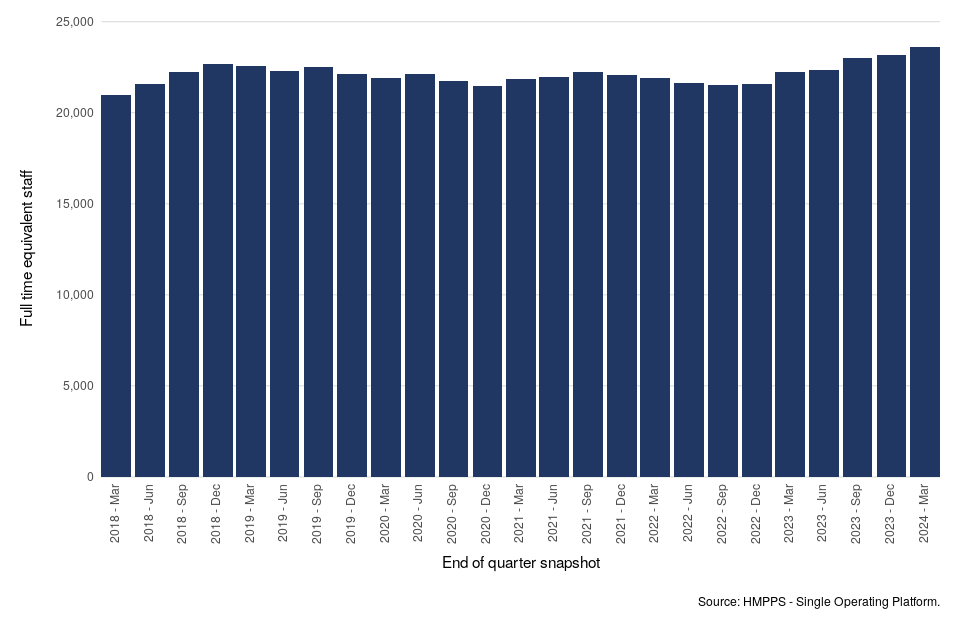
Figure 3 shows a quarterly trend of band 3 to 5 appointments and leavers since 2017/18. Over the year to 31 March 2024,
5,264 band 3 to 5 officers were appointed (consisting of direct new recruits and existing staff who converted to a band 3 officer grade),
an increase of 601 (12.9%) compared to 4,663 in the previous year. Looking at the quarterly figures, the headcount of new band 3 to 5 officer appointments increased by 195 (16.3%) from 1,198 between October and December 2023 to 1,393 between January and March 2024 (Table 17).
The headcount of band 3 to 5 prison officers who left HMPPS in the year ending 31 March 2024 was 3,077, which is a decrease of 254 (7.6%) compared to the year ending 31 March 2023. Examining reasons for leaving, 65.1%
of prison officers who left in the year ending 31 March 2024 resigned from their roles (down from 66.6% in the year ending 31 March 2023). Of the other prison officers who left HMPPS in the year ending 31 March 2024, 16.8% were dismissed and 5.6% retired; the proportion dismissed are up from 15.6% compared to previous year while the number retiring are down from 5.7%.
Figure 3: Newly appointed band 3 to 5 prison officers and band 3 to 5 prison officer leavers, April 2017 to 31 March 2024 (Source: Table 17)

Joiners and leavers are not the only movements into and out of the band 3 to 5 officer grouping. There are also typically differences in the proportion of new joiners and older officers who work part time as well as movements between grades, such as internal movements to non-frontline roles or promotions to operational managers. Changes such as staff switching from full time to part time also have the effect of reducing the FTE of officers available as they progress through their career. For these reasons, the change in FTE does not directly reflect the difference between the number of joiners and leavers.
The number of band 2 OSG staff who joined HMPPS in the year ending
31 March 2024 was 1,775: a decrease of 155 (8.0%) compared to the previous year ending 31 March 2023. There was a decrease of 109 (5.8%) since the year ending 31 December 2023. The headcount number of band 2 OSG staff who left HMPPS was 915, which is a decrease of 145 (13.7%) compared to the year ending 31 March 2023 and a decrease of 20 (2.1%) compared to the year ending 31 December 2023.
3. Probation practitioners and senior probation officers
5,139 FTE band 4 probation officers in post (as at 31 March 2024)
This figure is an increase of 718 FTE (16.2%) since 31 March 2023 and an increase of 386 FTE (8.1%) probation officers compared to 31 December 2023. In addition to the band 4 probation officers, there were 5,857 FTE band 3 probation services officers: a decrease of 1,052 FTE (15.2%) since 31 March 2023 and a decrease of 446 FTE (7.1%) since 31 December 2023.
Key grades in the Probation Service include band 3 probation services officers, band 4 probation officers (collectively known as probation practitioners), as well as band 5 senior probation officers. Staff who are training to be a probation officer work as a probation services officer during their training, so a proportion of the probation services officers in post will be working towards the professional probation officer qualification.
As of the June 2019 publication, a statistics annex has been added to this bulletin which presents figures on Probation Officers in post, their required staffing level, in addition to the number of trainee and qualified Probation Officers.
As at 31 March 2024, there were 5,857 FTE band 3 probation services officers in post, a decrease of 1,052 FTE (15.2%) over the past year and a decrease of 446 FTE (7.1%) over the quarter. In 2023/24 compared to 2022/23 we saw a lower number of trainee probation officers starting courses (543 in 2023/24 compared to 1,514 in 2022/23), which has contributed towards this net decrease. A contributing factor to the net decrease in probation services officers is the qualification of trainee probation officers, with many qualifiers taking up posts at the band 4 qualified probation officer grade. There were 5,139 FTE band 4 probation officers, representing an increase of 718 FTE (16.2%) over the past year and an increase of 386 FTE (8.1%) compared to the previous quarter; and 1,493 FTE band 5 senior probation officers, showing an increase of 61 (4.2%) over the previous year and no substantial change since the last quarter (Figure 4).
Figure 4: Number of probation officers, probation services officers and senior probation officers in post on an FTE basis, 31 March 2018 to 31 March 2024 (Source: Table 3)
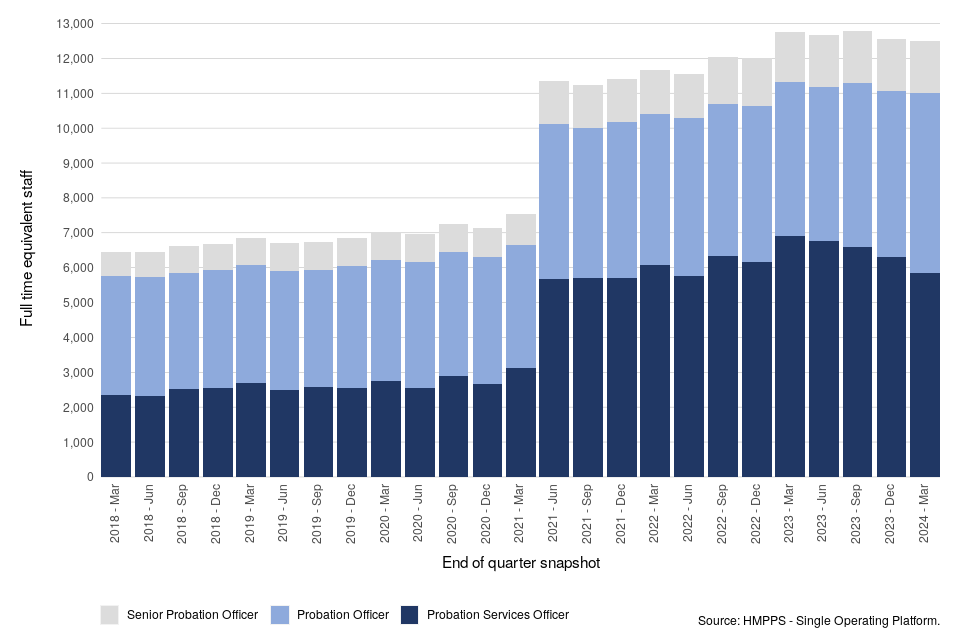
In the past year, 1,074 probation services officers were appointed, some of whom will be training to become qualified probation officers. This is a decrease of 1,311 (55.0%) compared to the year ending 31 March 2023 and a decrease of 851 (44.2%) compared to the number appointed in the year ending 31 December 2023. Within the Probation Service, there were 5,113 FTE Probation Officers in post, a shortfall of 1,680 FTE against the required staffing level of 6,794 FTE. There were 1,785 staff, equivalent to 1,759 FTE, undertaking the PQiP training as at 31 March 2024 (please refer to the Prison and Probation Officer Recruitment Annex for more details). In addition to the Probation Officers and current trainees, there were 24 FTE PQiP trainees who had completed their training as at 31 March 2024, but were waiting to take up a substantive Probation Officer post (or in some cases were not in a Probation Officer post for other reasons).
In the past year, 848 probation services officers left the service. This is an increase of 16 (1.9%) compared to the year ending 31 March 2023 and no substantial change compared to the number who left in the year ending 31 December 2023.
4. Joiners and Leavers
Leaving rate of 12.8% amongst band 3-5 prison officers (for the 12 months ending 31 March 2024)
This is a decrease of 1.7 percentage points compared to the year ending 31 March 2023. The overall leaving rate across HMPPS over the past year stood at 11.3%, which is a decrease of 1.1 percentage points compared to the year ending 31 March 2023 of 12.5%
Over the past year, 11,239 staff joined HMPPS, which is a decrease of 423 (3.6%) compared to the year ending 31 March 2023. These joiners consisted of 7,251 across PSP, 440 in the YCS, 3,212 in the Probation Service, and 336 in HMPPS HQ and Area Services. Compared to the year ending 31 March 2023, these numbers of joiners represent an increase of 4.7% for PSP, an increase of 29.0% for YCS, a decrease of 21.3% for Probation Service, and an increase of 7.7% for HMPPS HQ and Area Services.
A contributing factor to the large increases in the Probation Service staff has been the acceleration of the recruitment of trainee Probation Officers in previous years. This resulted in the onboarding of 1,514 trainee Probation Officers in the 2022/23 financial year. This resource is included in the Band 3 Probation Service Officers grade and therefore influenced the increase in joiners seen at this grade. We continue to run a unified model of recruitment for key operational grades (including Band 3 Probation Service Officers in priority regions). This more concentrated approach has resulted in a lower volume of new joiners at these key grades, with the number of trainee Probation Officers joining in 2023/24 falling to 543.
There were 8,030 leavers in the year ending 31 March 2024, which is no substantial change compared to the year ending 31 March 2023. This includes 4,723 leavers from PSP (a decrease of 9.2%), 287 from YCS (an increase of 4.4%), 2,360 from the Probation Service (an increase of 12.5%), and 660 from HMPPS HQ and Area Services (an increase of 49.7%).
4.1 Leaving Rates[footnote 3]
The overall HMPPS leaving rate for the year to 31 March 2024 was 11.3% compared to 12.5% for the year to 31 March 2023 (Figure 5); a decrease of 1.1 percentage points. For the year up to 31 March 2021, the increased uncertainty in the employment market following the COVID-19 pandemic may have contributed to the drop in the number of resignations during most of the year, therefore impacting on the overall reduced leaving and resignation rates. Although the latest leaving rates for most grades apart from Senior Probation Officers, are still higher than pre-pandemic levels, most have shown a decrease over the last 12 months.
Figure 5: Annual leaving rates of permanent staff in key operational grades (excluding VEDSR), from the 12 months to 31 March 2018 to the 12 months to 31 March 2024 (Source: Table 11)

4.2 Resignation Rates[footnote 4]
The overall HMPPS resignation rate for the 12 months to 31 March 2024 was 7.1%, compared to 8.1% for the year to 31 March 2023 (Figure 6). For band 3-5 officers, the resignation rate was 8.4% in the year ending 31 March 2024, which is a decrease of 1.4 percentage points since the year ending 31 March 2023. The resignation rate for OSG staff was 10.8% for the year ending 31 March 2024, which is a decrease of 3.2 percentage points since the year ending 31 March 2023.
For Probation Service overall, the resignation rate was 6.8% for the year ending 31 March 2024. This represents a slight decrease of 0.2 percentage points compared to the year ending 31 March 2023. Amongst the operational grades within the Probation Service, probation services officers had the highest resignation rate at 8.6%, a decrease of 1.1 percentage points since the year ending 31 March 2023.
Figure 6: Annual resignation rates of permanent staff in key operational grades, from the 12 months to 31 March 2018 to the 12 months to 31 March 2024 (Source: Table 12)
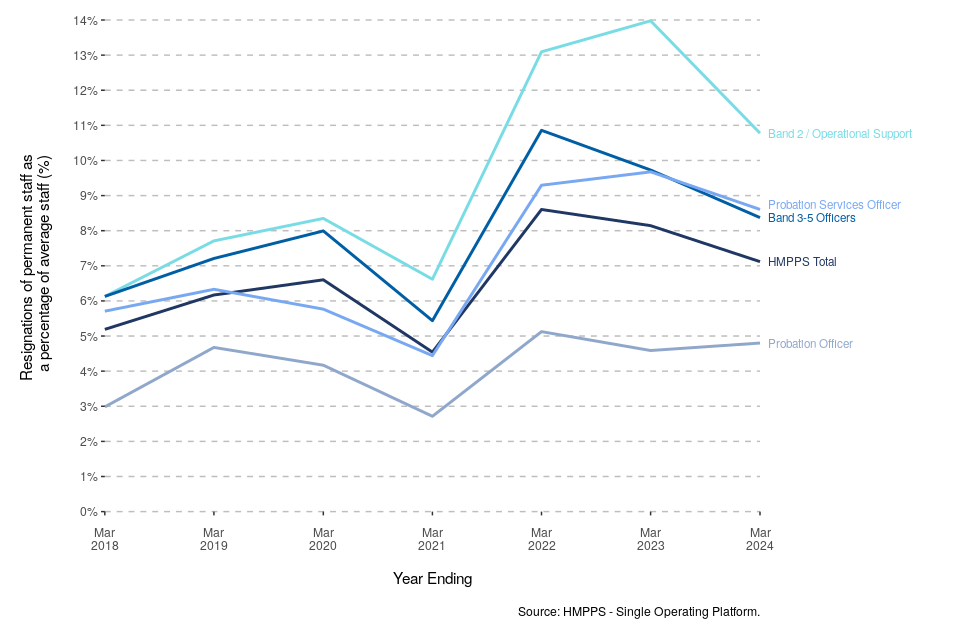
5. Sickness absence
HMPPS staff lost an average of 11.2 working days to sickness absence in the 12 months ending 31 March 2024
This represents a decrease of 1.5 average working days lost (AWDL) compared to the year ending 31 March 2023 (12.7 working days lost).
In the year ending 31 March 2024, HMPPS staff lost an average of 11.2 working days to sickness absence. This is a decrease from 12.7 average working days lost for the year ending 31 March 2023, and an increase of 0.9 days compared to the predominantly COVID-19 free year ending 31 March 2020.
YCS staff had the highest sickness absence rate at 16.7 AWDL, followed by Probation Service (12.5 AWDL), PSP (11.0 AWDL), and HQ and Area Services (5.9 AWDL) (Figure 7). Compared to the year ending 31 March 2023, these represent a decrease of 1.7 days for YCS, a decrease of 0.2 days for Probation Service, a decrease of 2.4 days for PSP, and a slight decrease of 0.2 days for HQ and Area Services staff.
Figure 7: Average working days lost to sickness absence, 12 months to 31 March 2018 to 12 months to 31 March 2024 (Source: Table 18)
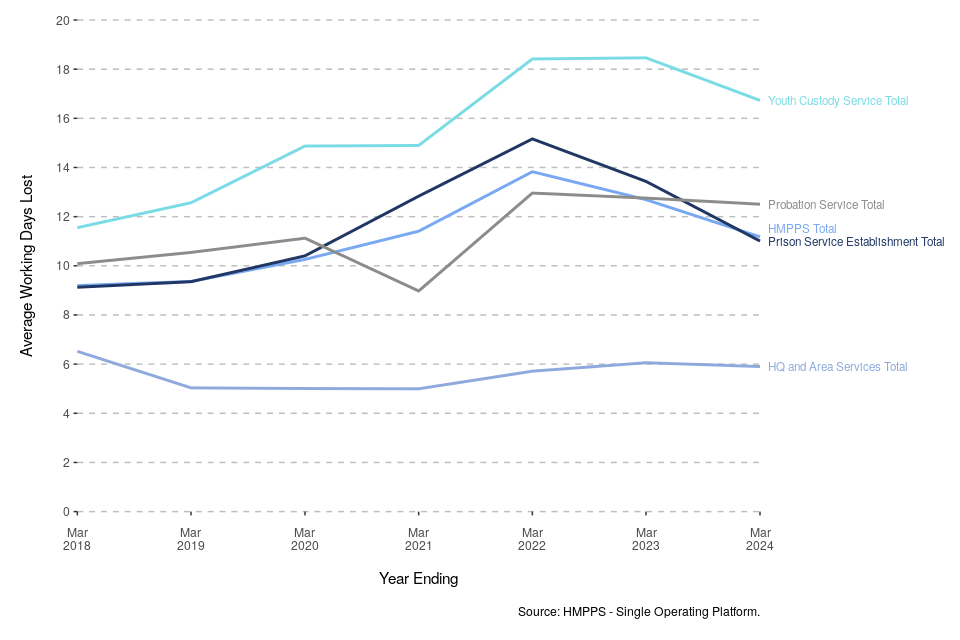
The most common category of sickness absence in terms of days lost was mental ill health, corresponding to 40.8% of working days lost in the past year. This category was most prevalent for probation officers, where 60.7% of working days lost were attributed to mental ill health.
For HMPPS overall the category that accounted for the second largest proportion of working days lost was musculoskeletal system (17.5%). Together the top two categories accounted for 58.3% of all working days lost.
6. Equality and Diversity
Data on the protected characteristics of ethnicity, disability, sexual orientation, and religion/belief are collected from self-declared, non-compulsory fields. Consequently, only figures for which declaration rates have reached a threshold of 60% or above have been reported in the following section. Representation rates show the percentage within a specified category out of all those who have declared (i.e. excluding those who have not responded or those who have indicated they do not wish to declare).
For staff in post as at 31 March 2024 the main representation rates were as follows; 54.7% of staff were female, 14.2% were ethnic minorities, 16.9% disabled, 7.7% were Lesbian, Gay, Bisexual and Other (LGBO) and 9.1% were non-Christian.
For new staff joining in the 12 months to 31 March 2024 the main representation rates were as follows; 52.1% of staff were female, 23.4% were ethnic minorities, 11.5% disabled, 9.7% were LGBO and 11.6% were non-Christian.
For staff leaving in the 12 months to 31 March 2024 the main representation rates were as follows; 51.3% of staff were female, 15.2% were ethnic minority, 18.8% disabled, 8.5% were LGBO and 9.8% were non-Christian.
6.1 Age
The largest individual age group across all of HMPPS at 31 March 2024 was 30-39 year olds with 17,379 staff (25.2%). The number of staff aged under 30 increased by 747 in the 12 months to 31 March 2024 compared to the previous year and made up 21.2% of the HMPPS workforce. HQ and Area Services had the oldest workforce, consisting of 59.1% of staff who were aged 40 or over. This is compared to 55.2% among Probation Service staff, 52.4% among PSP staff, and 43.0% among YCS staff. Those aged under 30 make up the highest proportion of joiners (44.8%) overall, and those aged under 30 make up the highest proportion of leavers (28.5%) overall.
Figure 8: Age of HMPPS staff, as at 31 March 2024 (Source: Table 5)
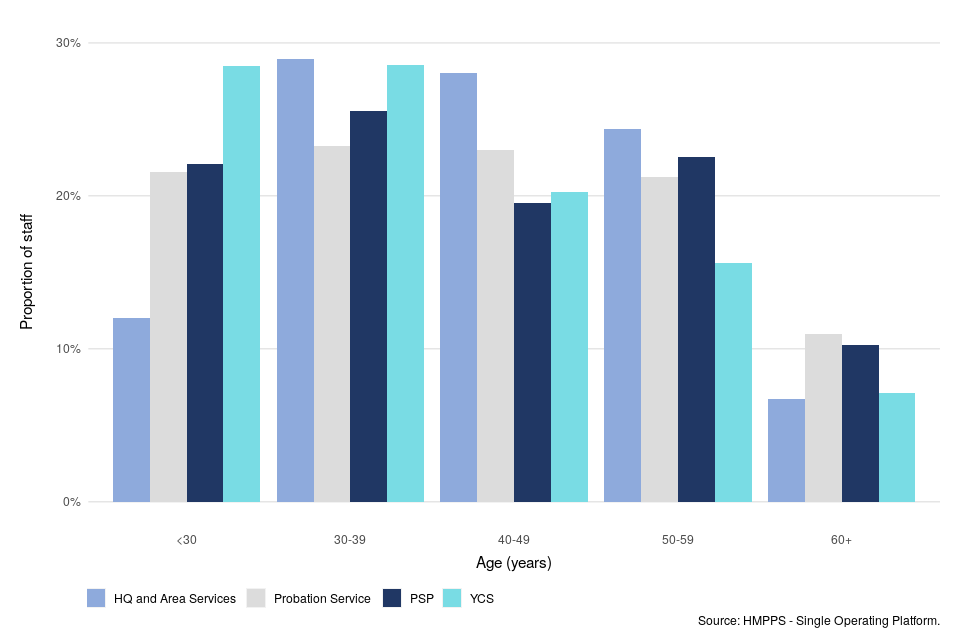
6.2 Gender
As at 31 March 2024, 54.7% of HMPPS staff overall were female, which is no substantial change compared to the previous year. Female representation was highest within the Probation Service at 75.7%, compared to 64.3% in HQ and Area Services, 49.4% in the YCS, and 41.8% in PSP. Across all of HMPPS, over the 12 months to 31 March 2024, 52.1% of joiners and 51.3% of leavers were female.
Figure 9: Gender of HMPPS staff, as at 31 March 2024 (Source: Table 5)

6.3 Full time/part time status
Full time/part time is a status that may fluctuate across an individual’s career. Part time as a grouping covers a wide range of working patterns and working hours. Within HMPPS overall, 14.6% of the workforce were identified as working part time, representing no substantial change compared to the previous year. Working on a part time basis is more common amongst staff in the Probation Service. As at 31 March 2024, 20.6% of Probation Service staff were working part time, compared to 12.5% of staff in PSP, 8.6% of staff in YCS, and 8.5% of staff in HQ and Area Services.
Only 8.9% of joiners worked on a part time basis, which is to be expected given this period usually marks the start of an individual’s career, whilst 17.8% of leavers were recognised as having part time status.
Figure 10: Working pattern of HMPPS staff, as at 31 March 2024 (Source: Table 5)
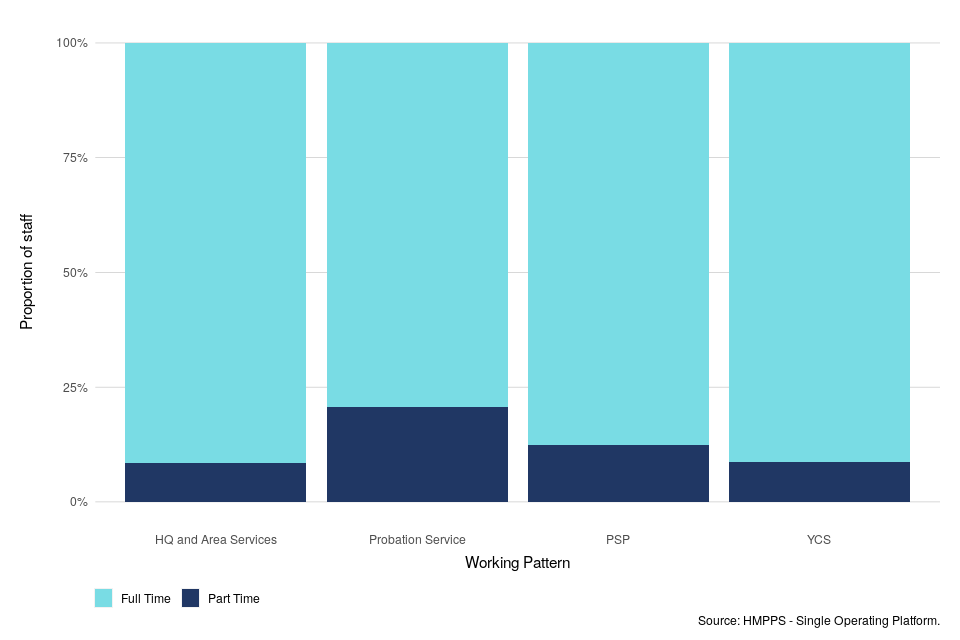
6.4 Ethnicity
As at 31 March 2024, 14.2% of HMPPS staff who had declared their ethnicity were from ethnic minorities backgrounds, which is an increase of 1.6 percentage points compared to the previous year. PSP had the lowest representation rate with 11.8% of staff who declared their ethnicity being ethnic minority (an increase of 2.0 percentage points since 31 March 2023), compared to 13.4% of staff in HQ and Area Services (no substantial change since 31 March 2023), 18.0% of staff in Probation Service (a slight increase of 0.9 percentage points since 31 March 2023), and 22.3% of staff in YCS (an increase of 3.6 percentage points since 31 March 2023).
In the 12 months to 31 March 2024, 15.2% of leavers across all of HMPPS who had declared their ethnicity were from ethnic minority backgrounds.
Figure 11: Ethnicity of HMPPS staff, as at 31 March 2024 (Source: Table 5)
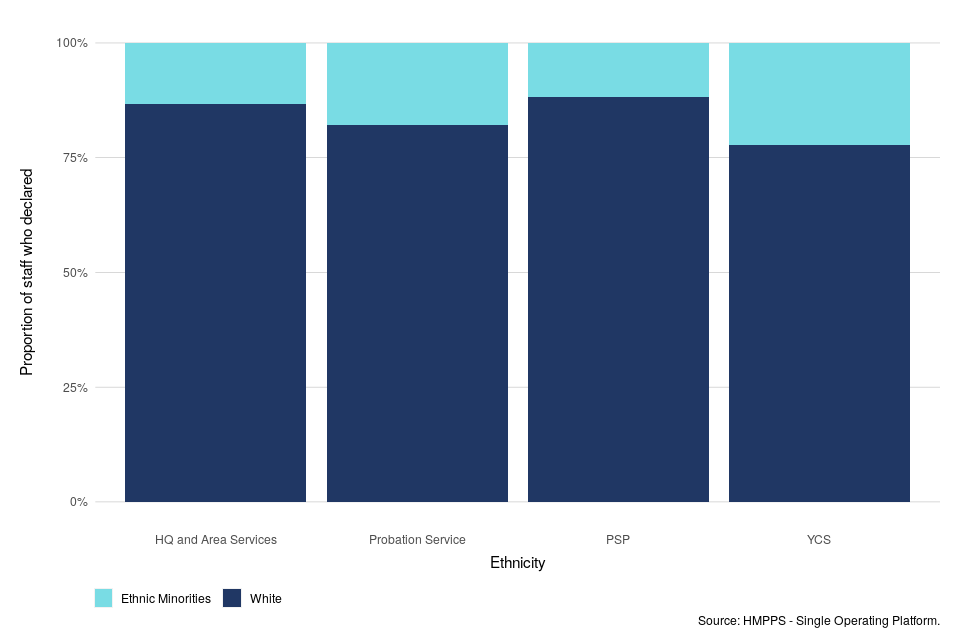
6.5 Other Protected Characteristics
As at 31 March 2024, 16.9% of HMPPS staff who had declared their disability status were disabled. PSP had the lowest representation rate with 13.0% of staff who declared their disability status being disabled, compared to 13.3% of staff in YCS, 16.4% of staff in HQ and Area Services, and 23.9% of staff in Probation Service. In the 12 months to 31 March 2024, 11.5% of joiners and 18.8% of leavers across all of HMPPS who had declared their disability status were disabled.
As at 31 March 2024, Lesbian, Gay, Bisexual and Other (LGBO) staff represented 7.7% of HMPPS staff who had declared their sexual orientation. HQ and Area Services had the lowest representation rate with 6.9% of staff who declared their sexual orientation identifying as LGBO, compared to 7.8% of staff in PSP, 7.8% of staff in Probation Service, and 8.6% of staff in YCS. In the 12 months to 31 March 2024, 9.7% of joiners and 8.5% of leavers across all of HMPPS who had declared their sexual orientation were LGBO.
As at 31 March 2024, 9.1% of HMPPS staff who had declared their religion or belief followed another (non-Christian) religion. PSP had the lowest representation rate with 7.9% of staff following a non-Christian religion, compared to 8.9% of staff in HQ and Area Services, 10.9% of staff in Probation Service, and 12.6% of staff in YCS. In the 12 months to 31 March 2024, 11.6% of joiners and 9.8% of leavers across all of HMPPS who had declared their religion were non-Christian.
No data are currently presented or available for the other protected characteristics of Marriage and Civil Partnership, Pregnancy and Maternity.
Data are not collected for Gender Reassignment as those in receipt of gender recognition certificates are recorded as their legal gender, and are not identified as being transgender in accordance with the Gender Recognition Act 2004 and the Equality Act 2010.
Further Information
Accompanying files
As well as this bulletin, the following products are published as part of this release:
-
A technical guide providing details of the HMPPS workforce structure as well as how the data are collected and processed. Information on the revisions policy and disclosure relevant to HMPPS staffing data is also included.
-
A set of summary tables for the latest quarter and year as well as over time.
-
An additional annex showing a quarterly time series excluding all staff who were not an active member of the workforce and receiving pay on the relevant snapshot date from our staff in post counts for each quarter between March 2017 to March 2024.
-
A supplementary annex presenting statistics on Probation Officers in post, their required staffing level, and the number of trainee and qualified Probation Officers. in addition it includes published quarterly hours adjusted Staff in Post, Target Staffing and Difference at establishment level for Band 3-5 Prison Officers
-
A supplementary annex presenting statistics on the staff recruited as part of the ‘Great Place to Work for Veterans’ recruitment campaign.
Official statistics
The statistics in this bulletin are classified as official statistics. The Statistics and Registration Service Act 2007 defines ‘official statistics’ as all those statistical outputs produced by the UK Statistics Authority’s executive office (the Office for National Statistics), by central Government departments and agencies, by the devolved administrations in Northern Ireland, Scotland, and Wales, and by other Crown bodies (over 200 bodies in total). The statistics in this bulletin comply with all aspects of the Code of Practice for Official Statistics. The Code encourages and supports producers of statistics to maintain their independence and to ensure adequate resourcing for statistical production. It helps producers and users of statistics by setting out the necessary principles and practices to produce statistics that are trustworthy, high quality and of public value.
Official statistics in development
Official statistics in development are a subset of newly developed or innovative official statistics undergoing evaluation. They are developed under the guidance of the Head of Profession for Statistics (HoP) and published to involve users and stakeholders in the assessment of their suitability and quality at an early stage. Therefore, we would like to receive feedback as to how useful they are, whether a different analysis would be preferable, or any other comments about them. If you wish to send any views you may have about these Official statistics in development, please use the contact details below.
Contact
Press enquiries should be directed to the Ministry of Justice press office:
https://www.gov.uk/government/organisations/ministry-of-justice/about/media-enquiries
Other enquiries about these statistics should be directed to:
Rob Hartley
Workforce Statistics & Analysis
Data and Analysis Directorate
Ministry of Justice
10 South Colonnade
London
E14 4PH
Email: robert.hartley@justice.gov.uk
Next update: 15 August 2024
URL: www.gov.uk/government/collections/national-offender-management-service-workforce-statistics
© Crown copyright
Produced by the Ministry of Justice
Alternative formats are available on request from robert.hartley@justice.gov.uk
-
This includes staff in Probation Service grades working in other parts of HMPPS. ↩
-
Percentage of staff with a permanent contract of employment who left HMPPS, including individuals who have retired early, but excluding staff who left due to voluntary early departure schemes and redundancy (VEDSR). ↩
-
Percentage of staff with a permanent contract of employment who resigned from HMPPS. ↩
